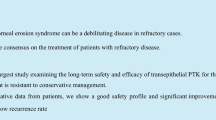Abstract
Background
Long-term application of topical steroids following penetrating keratoplasty is disadvantageous due to side effects (steroid response, cataract, surface disorders). In this study we investigated the efficacy of topical pimecrolimus regarding clear graft survival following allogeneic orthotopic keratoplasty in rats.
Methods
A total of 46 penetrating keratoplasties were performed using Fisher rats (allogeneic groups) and Lewis rats (syngeneic group) as donors and Lewis rats as recipients: group 1 (n = 11), allogeneic control without therapy; group 2 (n = 12), syngeneic control; group 3 (n = 11), mycophenolate mofetil (MMF) 40 mg/kg body weight; group 4 (n = 12), pimecrolimus 1% ointment twice daily. Four animals of each group were sacrificed for immunohistological evaluation on day 14. Therapy was administered for 18 days. The grafts were evaluated once every 3 days regarding opacity, oedema and vascularisation. Graft rejection was defined as total graft opacity.
Results
Mean rejection-free graft survival was 11.4 days in group 1 (allogeneic control), 100 days (total follow-up time) in group 2 (syngeneic control), 24.0 days in group 3 (MMF 40 mg/kg) and 11.6 days in group 4 (topical pimecrolimus). The immunohistological evaluation showed no statistically significant difference in cell infiltration of the grafts comparing groups 1 and 4.
Conclusions
Topical immunosuppression with pimecrolimus does not prolong graft survival in the allogeneic keratoplasty rat model.




Similar content being viewed by others
References
Birnbaum F, Böhringer D, Sokolovska Y et al (2005) Immunosuppression with cyclosporine A and mycophenolate mofetil after penetrating high-risk keratoplasty: a retrospective study. Transplantation 79:964–968
Birnbaum F, Reis A, Reinhard T (2007) Immunosuppression following penetrating keratoplasty. Ophthalmologe 104:371–372
Birnbaum F, Reis A, Reinhard T (2007) Topical immunosuppressives after penetrating keratoplasty. Ophthalmologe 104:381–387
Gisondi P, Ellis CN, Girolomoni G (2005) Pimecrolimus in dermatology: atopic dermatitis and beyond. Int J Clin Pract 59:969–974
Herbort CP, Matsubara M, Nishi M et al (1989) Penetrating keratoplasty in the rat: a model for the study of immunosuppressive treatment of graft rejection. Jpn J Ophthalmol 33:212–220
Hikita N, Lopez JS, Chan CC et al (1997) Use of topical FK506 in a corneal graft rejection model in Lewis rats. Invest Ophthalmol Vis Sci 38:901–909
Kaplan EL, Meier P (1958) Nonparametric estimation from incomplete observations. J Am Stat Assoc 53:457–481
Ling M, Gottlieb A, Pariser D et al (2005) A randomized study of the safety, absorption and efficacy of pimecrolimus cream 1% applied twice or four times daily in patients with atopic dermatitis. J Dermatol Treat 16:142–148
Mayer K, Birnbaum F, Reinhard T et al (2004) FTY720 prolongs clear corneal allograft survival with a differential effect on different lymphocyte populations. Br J Ophthalmol 88:915–919
Nell B, Walde I, Billich A et al (2005) The effect of topical pimecrolimus on keratoconjunctivitis sicca and chronic superficial keratitis in dogs: results from an exploratory study. Vet Ophthalmol 8:39–46
Reinhard T, Mayweg S, Reis A et al (2005) Topical FK506 as immunoprophylaxis after allogeneic penetrating normal-risk keratoplasty: a randomized clinical pilot study. Transpl Int 18:193–197
Reinhard T, Reis A, Mayweg S et al (2002) Topical Fk506 in inflammatory corneal and conjunctival diseases. A pilot study. Klin Monatsbl Augenheilkd 219:125–131
Reis A, Birnbaum F, Reinhard T (2007) Systemic immunosuppressives after penetrating keratoplasty. Ophthalmologe 104:373–380
Reis A, Megahed M, Reinhard T et al (2000) Coadministration of the new macrolide immunosuppressant RAD and mycophenolate mofetil in experimental corneal transplantation. Transplantation 70:1397–1401
Reis A, Reinhard T, Sundmacher R et al (1998) Effect of mycophenolate mofetil, cyclosporin A, and both in combination in a murine corneal graft rejection model. Br J Ophthalmol 82:700–703
Author information
Authors and Affiliations
Corresponding author
Rights and permissions
About this article
Cite this article
Birnbaum, F., Schwartzkopff, J., Scholz, C. et al. Topical pimecrolimus does not prolong clear graft survival in a rat keratoplasty model. Graefes Arch Clin Exp Ophthalmol 245, 1717–1721 (2007). https://doi.org/10.1007/s00417-007-0657-7
Received:
Revised:
Accepted:
Published:
Issue Date:
DOI: https://doi.org/10.1007/s00417-007-0657-7




